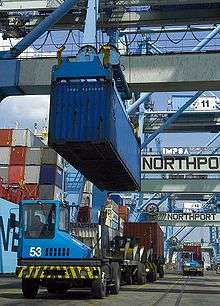Trade finance
| Finance |
|---|
 |
Trade finance signifies financing for trade, and it concerns both domestic and international trade transactions. A trade transaction requires a seller of goods and services as well as a buyer. Various intermediaries such as banks and financial institutions can facilitate these transactions by financing the trade.[1]
Description
While a seller (or exporter) can require the purchaser (an importer) to prepay for goods shipped, the purchaser (importer) may wish to reduce risk by requiring the seller to document the goods that have been shipped. Banks may assist by providing various forms of support. For example, the importer's bank may provide a letter of credit to the exporter (or the exporter's bank) providing for payment upon presentation of certain documents, such as a bill of lading. The exporter's bank may make a loan (by advancing funds) to the exporter on the basis of the export contract.
Other forms of trade finance can include Documentary Collection, Trade Credit Insurance, Factoring or forfaiting. Some forms are specifically designed to supplement traditional financing.
Secure trade finance depends on verifiable and secure tracking of physical risks and events in the chain between exporter and importer. The advent of new information and communication technologies allows the development of risk mitigation models which have developed into advance finance models. This allows very low risk of advance payment given to the Exporter, while preserving the Importer's normal payment credit terms and without burdening the importer's balance sheet. As trade transactions become more flexible and increase in volume, demand for these technologies has grown.
Products and services
Banks and financial institutions offer the following products and services in their trade finance branches.
- Letter of credit: It is an undertaking/promise given by a Bank/Financial Institute on behalf of the Buyer/Importer to the Seller/Exporter, that, if the Seller/Exporter presents the complying documents to the Buyer's designated Bank/Financial Institute as specified by the Buyer/Importer in the Purchase Agreement then the Buyer's Bank/Financial Institute will make payment to the Seller/Exporter.
- Bank guarantee: It is an undertaking/promise given by a Bank on behalf of the Applicant and in favour of the Beneficiary. Whereas, the Bank has agreed and undertakes that, if the Applicant failed to fulfill his obligations either Financial or Performance as per the Agreement made between the Applicant and the Beneficiary, then the Guarantor Bank on behalf of the Applicant will make payment of the guarantee amount to the Beneficiary upon receipt of a demand or claim from the Beneficiary.[2]
Bank guarantee has various types like 1. Tender Bond 2. Advance Payment 3. Performance Bond 4. Financial 5. Retention 6. Labour
- Collection and discounting of bills: It is a major trade service offered by the Banks. The Seller's Bank collects the payment proceeds on behalf of the Seller, from the Buyer or Buyer's Bank, for the goods sold by the Seller to the Buyer as per the agreement made between the Seller and the Buyer.
Methods of payment
Popular methods of payment used in international trade include:
cash with order(CWO)-the buyers pay cash when he places an order.
cash on delivery(COD)-the buyer pays cash when the goods are delivered.
documentary credit(L/C)-a Letter of credit (L/C) is used; gives the seller two guarantees that the payment will be made by the buyer:one guarantee from the buyer's bank and another from the seller's bank.
bills for collection(B/E or D/C) -here a Bill of Exchange (B/E)is used; or documentary collection (D/C) is a transaction whereby the exporter entrusts the collection of the payment for a sale to its bank (remitting bank), which sends the documents that its buyer needs to the importer’s bank (collecting bank), with instructions to release the documents to the buyer for payment.
open account-this method can be used by business partners who trust each other;the two partners need to have their accounts with the banks that are correspondent banks.
Methods of payment: Cash in Advance (Prepayment) Documentary Collections Letters of Credit Open Account Combining Methods of Payment Summary Resources Activities Assessment
References
- ↑ James Sinclair. "What is trade finance?". Trade Finance Global. Retrieved 27 July 2016.
- ↑ Sinclair, James (14 April 2014). "What is the difference between a Bank Guarantee and a Letter of Credit?". Trade Finance Global. Retrieved 23 September 2015.
External links
- "Trade Finance Guide: A Quick Reference for U.S. Exporters", International Trade Administration, U.S. Department of Commerce
- Federation of International Trade Associations
- AplonTrade: Free sample tool for trade financing with SWIFT messages.
- The Complete Guide to Trade Finance for Export Businesses
